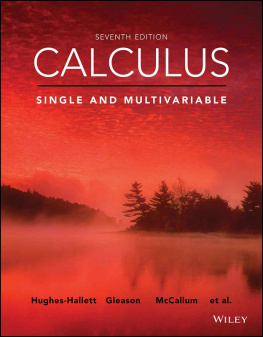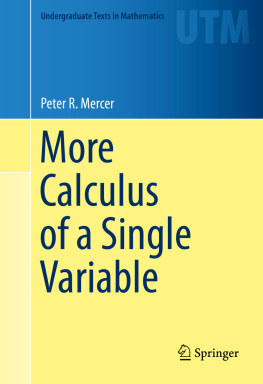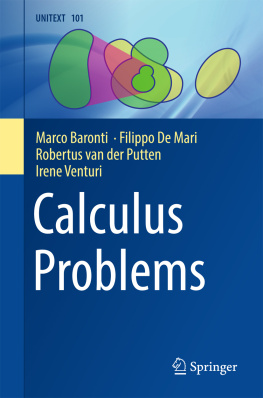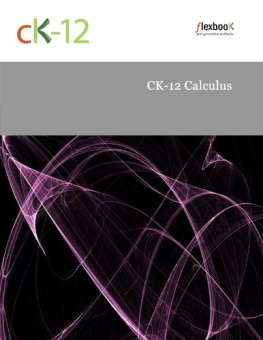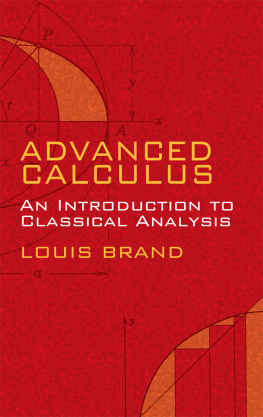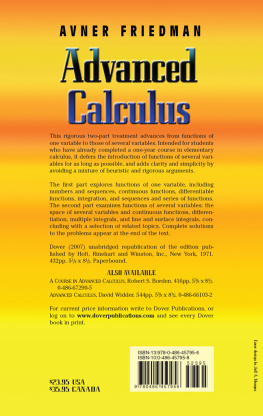Galina Filipuk - Single Variable Calculus: Vol 1
Here you can read online Galina Filipuk - Single Variable Calculus: Vol 1 full text of the book (entire story) in english for free. Download pdf and epub, get meaning, cover and reviews about this ebook. year: 2019, publisher: De Gruyter, genre: Children. Description of the work, (preface) as well as reviews are available. Best literature library LitArk.com created for fans of good reading and offers a wide selection of genres:
Romance novel
Science fiction
Adventure
Detective
Science
History
Home and family
Prose
Art
Politics
Computer
Non-fiction
Religion
Business
Children
Humor
Choose a favorite category and find really read worthwhile books. Enjoy immersion in the world of imagination, feel the emotions of the characters or learn something new for yourself, make an fascinating discovery.

- Book:Single Variable Calculus: Vol 1
- Author:
- Publisher:De Gruyter
- Genre:
- Year:2019
- Rating:4 / 5
- Favourites:Add to favourites
- Your mark:
- 80
- 1
- 2
- 3
- 4
- 5
Single Variable Calculus: Vol 1: summary, description and annotation
We offer to read an annotation, description, summary or preface (depends on what the author of the book "Single Variable Calculus: Vol 1" wrote himself). If you haven't found the necessary information about the book — write in the comments, we will try to find it.
Single Variable Calculus: Vol 1 — read online for free the complete book (whole text) full work
Below is the text of the book, divided by pages. System saving the place of the last page read, allows you to conveniently read the book "Single Variable Calculus: Vol 1" online for free, without having to search again every time where you left off. Put a bookmark, and you can go to the page where you finished reading at any time.
Font size:
Interval:
Bookmark:
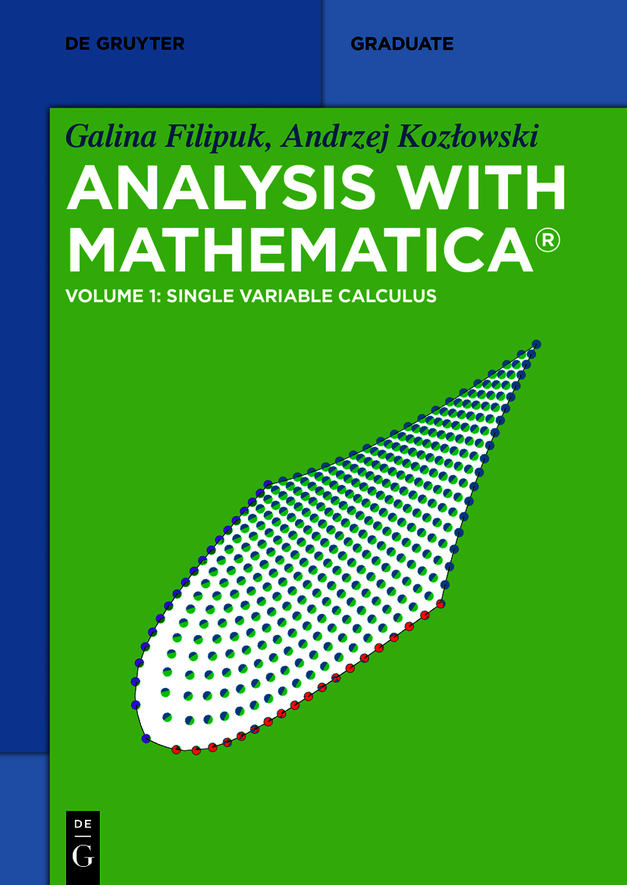
ISBN 9783110590135
e-ISBN (PDF) 9783110590142
e-ISBN (EPUB) 9783110590159
Bibliographic information published by the Deutsche Nationalbibliothek
The Deutsche Nationalbibliothek lists this publication in the Deutsche Nationalbibliografie; detailed bibliographic data are available on the Internet at http://dnb.dnb.de.
2019 Walter de Gruyter GmbH, Berlin/Boston
Mathematics Subject Classification 2010: 97I20, 97I30, 97I40, 97I50, 97N80,
The main objective of this two-volume book is to convince the readers that Mathematica ]).
Our approach is to describe some of the theory and to guide the readers through solutions to a number of classroom problems. Most of these problems come from the lecture notes [] for the course of analysis for computer science students, given at the University of Warsaw during 20112018. The problems we chose were the ones in which Mathematica could be genuinely useful in a way that did not involve simply applying some standard algorithm or plotting a graph, but which required the students to think and come up with some mathematical idea. Sometimes this idea is a guess inspired by a Mathematica calculation or a visual representation of the problem. In some special cases Mathematica can only verify this guess and sometimes it can prove its correctness in full generality. In all such cases we normally still want to obtain a rigorous mathematical proof. In some cases we will provide such proofs in detail, although sometimes we will only sketch them or limit ourselves to a special case, leaving the details and greater generality to the readers.
We will sometimes also use Mathematica s abilities to solve mathematical problems which are too difficult for us to solve by hand (sometimes because of their complexity and sometimes because the solution requires mathematical knowledge that lies beyond the scope of this book). We believe that such examples are useful and interesting because they show how the strengths of Mathematica (or other computer programs) can complement human weaknesses and vice versa. When using a computer program as an aid in mathematics it is important to understand what such programs are well suited to and what they are not, and also what kind of problems (including incorrect answers) one can run into. To learn to judiciously use a computer is becoming a necessity in many areas of science and mathematics and we hope our book will prove useful in this respect.
We shall frequently state well-known mathematical theorems and often omit their proofs. Usually we will refer the readers to books included in the bibliography (except when the proof is simple enough for the readers to supply it themselves). In some cases we will only give a proof based on Mathematica or an illustration. There is a natural question that has been much discussed in recent years: when can results obtained by means of a computer software be regarded as mathematical proofs? The most popular view is that such results can be considered as proofs provided the source code of the mathematical software is open so that it can be examined to make sure that it is correct. In the case of commercial programs like Mathematica the source code is not publicly available so one should consider results obtained by means of such programs as tentative and prove them by mathematical means or at least confirm their validity by means of other, independent programs. Since our purpose is to use Mathematica as an educational tool, we shall not be concerned with the correctness of Mathematica s implementation of various algorithms and we will usually not try to describe them. However, the readers should be aware that the methods used by mathematical computer programs are usually very different from the ones used by humans. In addition, often the methods (algorithms) used by Mathematica to obtain even quite elementary results depend on mathematical tools much more advanced than the scope of this book. Among examples of this kind are solving transcendental (non-polynomial) equations and inequalities, computing finite sums and sums of series, integration, etc.
We have been teaching analysis with Mathematica at the University of Warsaw for computer science students for several years and we have found the above described approach quite effective. A typical mathematics course at the University of Warsaw consists of lectures at which the theory is taught and of accompanying problem classes. This book is primarily based on problem classes and therefore has a similar style. We only briefly sketch the necessary theoretical material and refer the readers for further details to standard textbooks, some of which can be found in the bibliography. Our book can also be seen as a supplement for any standard textbook on calculus or analysis and we shall cover standard first and second year calculus (analysis) topics, where we can benefit from using Mathematica a lot. Volume 1 is devoted to single-variable calculus and volume 2 to the many-variable case. Our examples belong to pure mathematics and we do not consider any applications in physics and other sciences. Many textbooks exist which deal with such applications.
Although this book is based on a course of analysis for computer science students, it was actually a traditional mathematical course illustrated with examples from Mathematica rather than a course of constructive or algorithmic mathematics (i.e., the kind of mathematics that Mathematica itself makes use of). An excellent example of an introduction to analysis of the latter kind is [) have a very high complexity. This motivates the search for methods of solving problems quite different from the standard ones (an example of this is the standard algorithm for integrating rational functions, taught in all traditional Calculus courses, which is unusable in practice due to its need to factorize arbitrary polynomials). Again, in this book we only point out the existence of these important issues.
As mentioned earlier, we assume some familiarity with the programming language used by Mathematica (Wolfram Language), which means its basic syntax, the structure of Mathematica expressions, different forms of expressions ( InputForm , TraditionalForm , FullForm ), patterns and pattern matching, etc. Recent versions of Mathematica can use the so called free-form input, which allows the user to use natural language to tell Mathematica to solve certain problems. Natural language has obvious advantages over formal languages. For example, Mathematica has functions Element and MemberQ but only MemberQ[{1,2,3},1] and Element[1,Integers] will produce the answer True . If we use free-form input, the questions is 1 an element of the set {1,2,3}?, is 1 a member of the set {1,2,3}? and is 1 a member of the rationals? will return the same answer True . Although free-form input is improving, it is still quite limited in scope and we have decided not to use it. Using a formal language has the advantage of clarity, which is essential when we want to do something more complicated than a single operation like solving an equation or plotting a graph. Of course there is a price. Not only do we have to use the correct syntax (for example, in the Wolfram Language different kind of brackets (),{},[] have different meanings and must not be mixed up) but to use Mathematica effectively one needs to use its built-in functions. However, there are many thousands of them, each having a large number of options. In practice it means that one of the most important Mathematica skills is efficient use of its extensive documentation (the Wolfram Language & System Documentation Center). Whenever the readers come across an unfamiliar function or an unfamiliar option of a familiar function they should use ?FunctionName to obtain information about it. In fact, it is not necessary to remember the whole function name as long as Mathematica s autocomplete feature is turned on (it is by default). We expect the readers to look up the necessary information themselves but we will sometimes provide links to some selected help topics. We would also like to point out that this book is written in LaTeX and it is not possible to make the input and output exactly the way they would look in Mathematica . Most of our input cells will resemble InputForm with a mixture of StandardForm , while the output cells will mostly resemble StandardForm . Large input and output cells are sometimes shown as graphics. We shall use the large letter I in both input and output to represent the complex number
Font size:
Interval:
Bookmark:
Similar books «Single Variable Calculus: Vol 1»
Look at similar books to Single Variable Calculus: Vol 1. We have selected literature similar in name and meaning in the hope of providing readers with more options to find new, interesting, not yet read works.
Discussion, reviews of the book Single Variable Calculus: Vol 1 and just readers' own opinions. Leave your comments, write what you think about the work, its meaning or the main characters. Specify what exactly you liked and what you didn't like, and why you think so.



